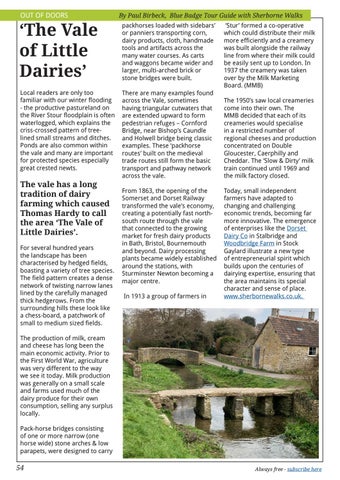OUT OF DOORS
‘The Vale of Little Dairies’ Local readers are only too familiar with our winter flooding - the productive pastureland on the River Stour floodplain is often waterlogged, which explains the criss-crossed pattern of treelined small streams and ditches. Ponds are also common within the vale and many are important for protected species especially great crested newts.
The vale has a long tradition of dairy farming which caused Thomas Hardy to call the area ‘The Vale of Little Dairies’. For several hundred years the landscape has been characterised by hedged fields, boasting a variety of tree species. The field pattern creates a dense network of twisting narrow lanes lined by the carefully managed thick hedgerows. From the surrounding hills these look like a chess-board, a patchwork of small to medium sized fields.
By Paul Birbeck, Blue Badge Tour Guide with Sherborne Walks packhorses loaded with sidebars’ or panniers transporting corn, dairy products, cloth, handmade tools and artifacts across the many water courses. As carts and waggons became wider and larger, multi-arched brick or stone bridges were built. There are many examples found across the Vale, sometimes having triangular cutwaters that are extended upward to form pedestrian refuges – Cornford Bridge, near Bishop’s Caundle and Holwell bridge being classic examples. These ‘packhorse routes’ built on the medieval trade routes still form the basic transport and pathway network across the vale. From 1863, the opening of the Somerset and Dorset Railway transformed the vale’s economy, creating a potentially fast northsouth route through the vale that connected to the growing market for fresh dairy products in Bath, Bristol, Bournemouth and beyond. Dairy processing plants became widely established around the stations, with Sturminster Newton becoming a major centre. In 1913 a group of farmers in
‘Stur’ formed a co-operative which could distribute their milk more efficiently and a creamery was built alongside the railway line from where their milk could be easily sent up to London. In 1937 the creamery was taken over by the Milk Marketing Board. (MMB) The 1950’s saw local creameries come into their own. The MMB decided that each of its creameries would specialise in a restricted number of regional cheeses and production concentrated on Double Gloucester, Caerphilly and Cheddar. The ‘Slow & Dirty’ milk train continued until 1969 and the milk factory closed. Today, small independent farmers have adapted to changing and challenging economic trends, becoming far more innovative. The emergence of enterprises like the Dorset Dairy Co in Stalbridge and Woodbridge Farm in Stock Gaylard illustrate a new type of entrepreneurial spirit which builds upon the centuries of dairying expertise, ensuring that the area maintains its special character and sense of place. www.sherbornewalks.co.uk.
The production of milk, cream and cheese has long been the main economic activity. Prior to the First World War, agriculture was very different to the way we see it today. Milk production was generally on a small scale and farms used much of the dairy produce for their own consumption, selling any surplus locally. Pack-horse bridges consisting of one or more narrow (one horse wide) stone arches & low parapets, were designed to carry
54
Always free - subscribe here























